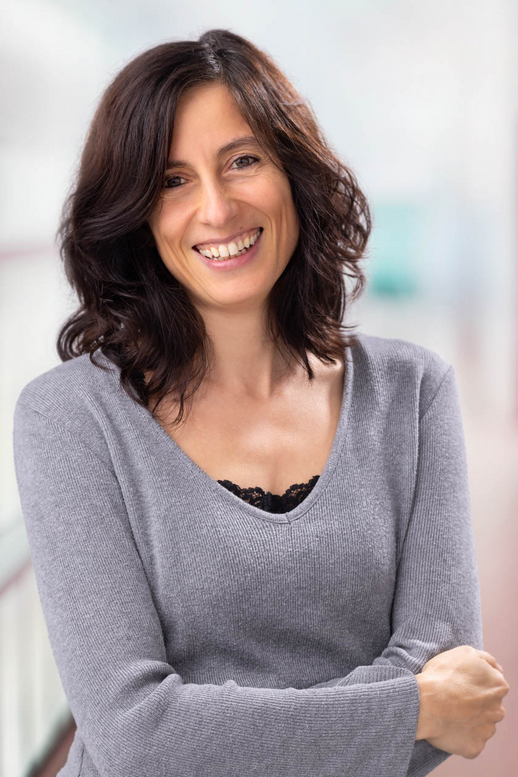Prof. Dr. Barbara Di Ventura

Contact
Institute of Biology II (Faculty of Biology)
University of Freiburg
T +49 761 203 2764
barbara.diventura(at)biologie.uni-freiburg.de
Further Information
In the Di Ventura lab, we are interested in understanding the role that dynamics play in controlling biological processes, especially gene expression in mammalian cells. To empower this type of research, we develop novel optogenetic tools to control the function and localization of proteins of interest. We also study the bacterial Min system, a beautiful example of self-organized spatially dynamic protein machinery. The LOV2 domain from Avena sativa and inteins are among our favorite molecular tools.
Keywords
synthetic biology; protein engineering; optogenetics; gene expression; Min system; inteins; AsLOV2 domain
Trilussa
“Se insisti e resisti raggiungi e conquisti”
10 selected publications:
- C-terminal eYFP fusion impairs Escherichia coli MinE function.
Palanisamy N, Öztürk MA, Akmeriç EB, Di Ventura B (2020).
Open Biol.10(5):200010 - Split intein-mediated selection of cells containing two plasmids using a single antibiotic.
Palanisamy N, Degen A, Morath A, Ballestin Ballestin J, Juraske C, Öztürk MA, Sprenger GA, Youn JW, Schamel WW, Di Ventura B (2019).
Nat Commun 10(1):4967. - Context-dependent activity of A domains in the tyrocidine synthetase.
Degen A, Mayerthaler F, Mootz HD, Di Ventura B (2019).
Sci Rep. 9(1):5119. doi: 10.1038/s41598-019-41492-8. - Engineering optogenetic control of endogenous p53 protein levels.
Wehler P, Di Ventura B (2019).
Applied Sciences 9(10): 2095 - Switchable inteins for conditional protein splicing.
Di Ventura B, Mootz HD (2018).
Biol Chem. 2018 doi: 10.1515/hsz-2018-0309. - Go in! Go out! Inducible nuclear protein localization
Di Ventura B, Kuhlman B (2016).
Curr Opin Chem Biol. 34:62-71. - Optogenetic control of nuclear protein export.
Niopek D, Wehler P, Roensch J, Eils R, Di Ventura B (2016).
Nat Commun. 7:10624. doi: 10.1038/ncomms10624 - Backbone circularization of Bacillus subtilis family 11 xylanase increases its thermostability and its resistance against aggregation.
Waldhauer MC, Schmitz SN, Ahlmann-Eltze C, Gleixner JG, Schmelas CC, Huhn AG, Bunne C, Büscher M, Horn M, Klughammer N, Kreft J, Schäfer E, Bayer PA, Krämer SG, Neugebauer J, Wehler P, Mayer MP, Eils R, Di Ventura B (2015).
Mol Biosyst. 11(12):3231-43 - Engineering light-inducible nuclear localization signals for precise spatiotemporal control of protein dynamics in living cells.
Niopek D, Benzinger D, Roensch J, Draebing T, Wehler P, Eils R, Di Ventura B (2014).
Nat Commun. 5:4404.
Highlighted in F1000 - Creating functional engineered variants of the single-module non-ribosomal peptide synthetase IndC by T domain exchange.
Beer R, Herbst K, Ignatiadis N, Kats I, Adlung L, Meyer H, Niopek D, Christiansen T, Georgi F, Kurzawa N, Meichsner J, Rabe S, Riedel A, Sachs J, Schessner J, Schmidt F, Walch P, Niopek K, Heinemann T, Eils R, Di Ventura B (2014).
Mol BioSyst. 10(7):1709-18. - Chromosome segregation by the Escherichia coli Min system.
Di Ventura B*, Knecht B, Andreas H, Godinez WJ, Fritsche M, Rohr K, Nickel W, Heermann DW, Sourjik V* (2013).
Mol Syst Biol. 9:686. *co-corresponding authors - Reconstitution of Mdm2-dependent post-translational modifications of p53 in yeast
Di Ventura B, Funaya C, Antony C, Knop M, Serrano L (2008).
PLoS One. 3(1):e1507



